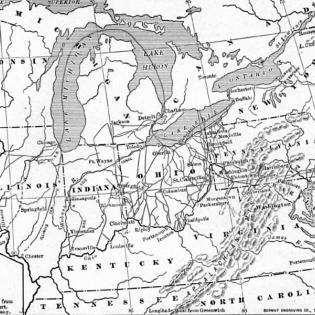Last Stop on the Underground Railroad
With similar motivations to present-day refugees, African Americans moved north in the mid-1800s to escape slavery and unsafe living conditions in the South. Detroit was an important location where Conductors on the Underground Railroad helped thousands to cross the Detroit River into Canada. In this lesson, we use visual literacy to analyze public art monuments that commemorate historical people and the personal risks that brought people to safety in Canada.
The learner will know and be able to:
- describe the goals of historical monuments and other forms of public art.
- give reasons why people take personal risks or give generously for the good of unknown others.
- copy of Gateway to Freedom Monument (see handout below)
-
photographs of the Underground Railroad monuments in Detroit and Windsor featuring DeBaptiste and other figures
-
Youth can explore the History of U.S. Philanthropy timeline to learn more about actions people take for equity.
Identify local public art or organizations that were formed to help people who were denied their rights.
What are the pros and cons of displaying historic events through public art? Why do you think individuals, organizations, or governments feel so strongly about the art they are willing to pay for the monuments to be created and displayed?
Instructions
Opening Question:
Why did people travel along the Underground Railroad, and why did people help them to reach safety? Compare this historical event to a current story of people helping refugees or supporting anti-racist education. Discuss why people (today and in history) take difficult actions with and for people who are denied their rights.
Display photographs of the Gateway to Freedom International Memorial to the Underground Railroad monuments in Detroit and Windsor. This website shows images of both monuments that tell the story from both sides of the Detroit River. Use the monument description to give some background on the Underground Railroad, George DeBaptiste, and the monuments.
Working in small groups, the young people discuss what they observe and share what they wonder about the two monuments. These visual literacy questions can guide their discussion:
- What is going on in the monuments?
- What do you see that makes you say that?
- What does this monument say to us?
- What more would you like to find out?
- What media was used to make it?
- What does this set of monuments remind you of? Is there a local public art or organization that shares a similar historical story?
On three posters hanging in the room with the following prompts, have the groups move poster to poster and write notes from their discussions:
- What did you notice and what does it make you think?
- What do you wonder?
- What do you think is the purpose of this public art?
Read the overview of the Gateway to Freedom Monument and its central figure George DeBaptiste. Discuss the provided questions.
Make a Connection:
The Statue of Liberty in New York was originally intended to honor the end of slavery, and there is a broken chain at her feet. How do the words we have come to associate with immigrants relate to abolition? Just like this pair of statues in Detroit/Windsor, what would be a possible counterpart statue to the Statue of Liberty and where would it be?
Handouts
Philanthropy Framework
-
Strand PHIL.I Definitions of Philanthropy
-
Standard DP 01. Define Philanthropy
-
Benchmark MS.1 Define philanthropy as individuals and organizations providing their time, talent, and/or treasures intended for the common good throughout history and around the world. Give examples.
-
Benchmark HS.1 Define philanthropy to include giving and sharing; volunteering; and private individual action intended for the common good. Explain how a volunteer individual/group can act for the common good.
-
-
-
Strand PHIL.II Philanthropy and Civil Society
-
Standard PCS 02. Diverse Cultures
-
Benchmark HS.5 Describe how women and minority groups have used the civil society sector as an alternative power structure.
-
Benchmark MS.5 Discuss examples of groups denied their rights in history.
-
Benchmark MS.7 Identify women and minorities who are or have been leaders in the civil society sector.
-
Benchmark HS.7 Identify and give examples of the important roles women and minorities have played in the civil society sector in history.
-
-
Standard PCS 04. Philanthropy and Geography
-
Benchmark HS.1 Identify international civil society sector organizations and map their locations.
-
Benchmark MS.1 Locate and map civil society organizations in the community.
-
-
Standard PCS 05. Philanthropy and Government
-
Benchmark HS.10 Discuss the results of private citizen voluntary action intended for the common good on public policy changes.
-
Benchmark MS.10 Give historic and contemporary examples of a voluntary action by an individual or a private organization that has helped to enhance a fundamental democratic principle.
-
-
-
Strand PHIL.III Philanthropy and the Individual
-
Standard PI 01. Reasons for Individual Philanthropy
-
Benchmark MS.10 Identify reasons why historic figures acted for the common good.
-
Benchmark HS.10 Identify reasons why historic figures acted for the common good.
-
Benchmark HS.4 Cite historical examples of citizen actions that affected the common good.
-
Benchmark MS.4 Identify and describe the actions of how citizens act for the common good.
-
-
